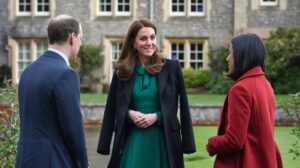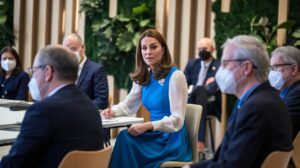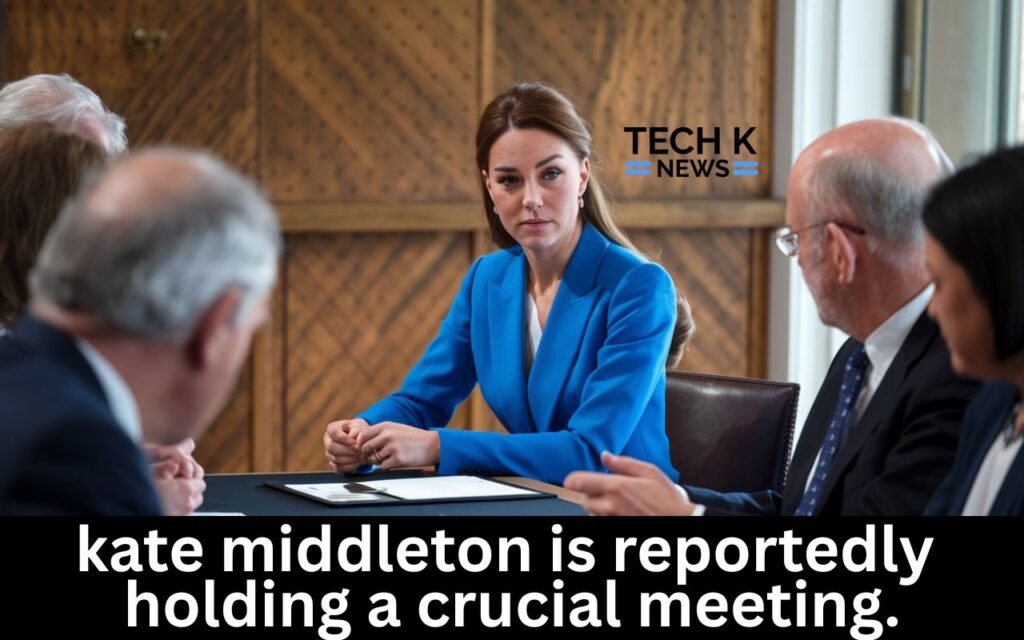Introduction
The British Royal Family has long been a subject of global fascination, but few moments in recent years have sparked as much intrigue as reports that Kate Middleton, the Princess of Wales, is convening a pivotal meeting at Kensington Palace. This gathering, shrouded in secrecy, is rumored to address a confluence of challenges facing the monarchy—ranging from strategic rebranding efforts to internal family dynamics and the institution’s evolving role in a rapidly changing society. As a senior royal known for her meticulous planning and compassionate leadership, Kate’s decision to spearhead this meeting underscores her growing influence within the Windsor dynasty.
Insiders suggest the meeting is not merely procedural but a calculated response to mounting pressures on the monarchy. The Royal Family has weathered a turbulent decade: Prince Harry and Meghan Markle’s departure, the passing of Queen Elizabeth II, and growing public debates about the Crown’s relevance in modern Britain. Against this backdrop, Kate’s role has become increasingly central. Her ability to balance tradition with progressive values—evident in her advocacy for mental health, early childhood development, and environmental sustainability—positions her as a linchpin in the monarchy’s efforts to remain relatable and impactful. This article explores the meeting’s potential agenda, its historical context, and the far-reaching implications for the Royal Family’s future.
The Purpose Behind the Meeting: Strategic Priorities and Philanthropic Vision
While Buckingham Palace has maintained its characteristic discretion, sources close to the royal household have hinted that the meeting’s agenda is both broad and ambitious. At its core, the gathering is expected to focus on the Royal Foundation, the charitable organization co-founded by Kate and Prince William in 2009. With its 15th anniversary approaching, the Foundation is poised to enter a new phase of global outreach. Initiatives like Heads Together (a mental health campaign) and Earthshot (an environmental prize) have already made waves, but insiders suggest Kate is pushing for even greater scalability.
One key topic will likely be the expansion of the Foundation’s early childhood development programs, a cause Kate has championed since 2020. Her landmark “5 Big Questions on the Under-Fives” survey, which garnered over 500,000 responses, revealed widespread public support for prioritizing early education and parental support. The meeting may outline plans to integrate these findings into national policy frameworks, potentially partnering with governments and NGOs to create systemic change. Additionally, discussions about climate action are anticipated, particularly as Earthshot gains momentum. The Foundation’s recent collaborations with tech innovators and grassroots activists could serve as a blueprint for future projects.
Beyond philanthropy, the meeting is expected to address the monarchy’s public image. Recent polls indicate that younger generations in the UK are less invested in the Crown, with some viewing it as an outdated institution. Kate’s team is reportedly exploring ways to leverage digital platforms—such as social media campaigns and virtual royal tours—to engage Gen Z and millennial audiences. This shift would align with her previous successes, including the viral popularity of her YouTube Q&A sessions on mental health.
Kate Middleton’s Ascendant Role: From Duchess to Diplomatic Leader
Since her marriage to Prince William in 2011, Kate Middleton has undergone a remarkable transformation from a private individual to a globally recognized stateswoman. Her journey has been defined by strategic patience; she spent years observing royal protocols, building relationships with charities, and refining her public persona. Today, she is not merely a figurehead but a visionary leader whose work intersects with pressing global issues.
Analysts argue that Kate’s strength lies in her ability to humanize the monarchy. Unlike traditional royal engagements—often characterized by ceremonial ribbon-cutting—her initiatives prioritize grassroots impact. For example, her visits to addiction recovery centers and homeless shelters are frequently unpublicized, emphasizing substance over spectacle. This approach has earned her widespread admiration, with a 2023 YouGov poll ranking her as the most popular royal after Prince William.
Critically, Kate’s leadership style reflects a modern understanding of soft power. By focusing on apolitical issues like mental health and education, she avoids partisan pitfalls while fostering cross-sector collaboration. Her recent speech at the United Nations, where she urged global leaders to prioritize early childhood development, marked a significant step in her diplomatic evolution. The Kensington Palace meeting may further cement her role as a bridge between the Crown and international institutions.

Key Attendees: A Blend of Royalty, Advisors, and Global Experts
The guest list for the meeting remains confidential, but royal commentators speculate that it will include a diverse array of voices. Prince William is certain to attend, given his joint leadership of the Royal Foundation. His involvement ensures alignment between the couple’s philanthropic goals and the monarchy’s broader strategy.
Senior advisors such as Sir David Manning, a former British ambassador to the U.S., are also likely to participate. Manning’s expertise in international relations could prove invaluable as the Foundation eyes global expansion. Additionally, representatives from Kate’s flagship charities—including Place2Be (a children’s mental health organization) and the Anna Freud Centre—are expected to provide on-the-ground insights.
Notably, the meeting may include communications strategists tasked with addressing recent PR challenges. The Royal Family has faced intense scrutiny over privacy concerns, particularly following Prince Harry’s revelations in Spare. Experts like Paddy Harverson, a former communications secretary to Prince Charles, could advise on balancing transparency with discretion.
Finally, environmental leaders such as David Attenborough or Christian Figueres (architect of the Paris Climate Agreement) might join remotely to discuss Earthshot’s next phase. Their inclusion would signal the Royal Foundation’s commitment to leveraging high-profile partnerships for maximum impact.
Agenda Deep Dive: Four Pillars of Discussion
- Charitable Innovation and Global Scaling
The Royal Foundation’s evolution from a UK-focused entity to a global player will dominate discussions. Proposals include launching regional hubs in Commonwealth nations, fostering local leadership in mental health and sustainability. For instance, a partnership with Kenya’s Maasai communities could integrate indigenous knowledge into Earthshot’s conservation efforts. - Digital Engagement and Youth Outreach
With 70% of Britons under 30 expressing indifference toward the monarchy, the meeting will explore rebranding strategies. Ideas on the table include a TikTok series documenting royal charitable work and interactive virtual tours of historic palaces. These efforts aim to demystify the Crown while highlighting its relevance to contemporary issues. - Crisis Management and Family Unity
The Sussexes’ ongoing rift with the Royal Family remains a thorny issue. Advisors may recommend private reconciliation efforts or public gestures of solidarity to quell media speculation. Additionally, plans to shield Prince George, Princess Charlotte, and Prince Louis from excessive public exposure will be debated, balancing their privacy with their eventual roles as future monarchs. - Policy Advocacy and Legislative Partnerships
Kate’s early childhood research could transition from awareness-raising to policy change. The meeting might outline collaborations with the UK Department of Education to integrate parental support programs into school curricula, backed by £50 million in Foundation funding.
Implications for the Monarchy: A Crossroads of Tradition and Modernity
The outcomes of this meeting could redefine the British monarchy’s trajectory. A successful expansion of the Royal Foundation’s initiatives would bolster the Crown’s image as a force for global good, countering criticisms of elitism. Conversely, missteps in messaging or strategy risk alienating both traditionalists and progressive audiences.
Domestically, the monarchy’s ability to align with public sentiment on issues like climate change and mental health will determine its longevity. Internationally, partnerships forged through Earthshot and similar programs could enhance the UK’s soft power, particularly in developing nations. For Kate personally, this meeting represents a career-defining moment—one that could solidify her legacy as a transformative royal figure.
Public and Media Reactions: A Global Spotlight
News of the meeting has ignited a media frenzy, with outlets dissecting every leaked detail. The BBC’s royal correspondent, Nicholas Witchell, praised Kate’s “strategic foresight,” while tabloids like The Daily Mail speculated about hidden tensions with Prince Harry. Social media reactions have been equally polarized: hashtags like #KateTheStrategist trended on Twitter, while critics questioned the meeting’s secrecy.
Internationally, the meeting has drawn attention from policymakers. In a Washington Post op-ed, former U.S. First Lady Michelle Obama applauded Kate’s focus on early childhood development, urging global leaders to follow her example. Meanwhile, Commonwealth nations like India and Jamaica have expressed interest in collaborating with the Royal Foundation, viewing it as a neutral platform for social progress.

Historical Precedents: Learning from Past Royal Summits
This is not the first time the Royal Family has convened a high-stakes meeting to navigate existential challenges. In 1992, following the annus horribilis—marked by divorces, scandals, and the Windsor Castle fire—Queen Elizabeth II hosted a summit that led to financial reforms and a slimmed-down monarchy. Similarly, in 2017, Prince Charles convened a climate conference that laid the groundwork for Earthshot.
Kate’s approach, however, differs in its emphasis on collaborative, data-driven solutions. By incorporating insights from academics and grassroots activists, she aims to create a model of royal leadership that is both authoritative and inclusive.
Conclusion: Shaping a Legacy for Generations to Come
As Kate Middleton prepares to lead this critical summit, the weight of history and expectation rests on her shoulders. Her ability to unite disparate stakeholders—royals, advisors, global leaders, and the public—will test her diplomatic acumen and vision. Whether the meeting produces groundbreaking policies or symbolic gestures, its true significance lies in its potential to redefine monarchy for the 21st century.
In an era of skepticism toward institutions, Kate’s blend of empathy, innovation, and strategic rigor offers a compelling template for the Crown’s survival. The world will be watching closely, not just for headlines, but for a glimpse of a monarchy that can honor its past while boldly embracing the future.


